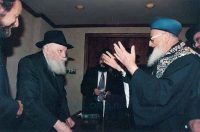The Mourning period:
It is accustomed amongst Jewry to observe certain customs of mourning within the period between Pesach and Shavuos.
The reason:[1] The reason behind this custom is because during this time period 12,000 study partners, which were the twenty four thousand students of Rebbe Akiva, passed away.[2] In commemoration of this tragedy we practice mourning customs throughout this period of time. [The purpose of this commemoration is in order so we distance ourselves from hatred, haughtiness, and fame, and rather acquire in our souls attributes of love, humility and peace.[3] Alternatively the reason behind the mourning period during this time is due to that according to some opinions[4] the period of Gihenom for the Reshaim is from Pesach until Shavuos. Alternatively it is because this is a time of judgment over the grains.[5]]
Why did the students die?
This was due to that the students did not act in a way of respect to each other.[6]
How did the students die?[7]
They died a terrible death. Some opinions say it was Askara.
When did the students die?[8]
They all died between Pesach and Atzeres [Shavuos].
When did the last of the students die?
Some Poskim[9] write the last of the 24,000 students died on Lag BaOmer. Others[10] write that the last of the students died on the 34th day of the Omer. Others[11] rule that the students died throughout the days between Pesach and Shavuos for a total of 33 days within that time. They did not die on any of the days that Tachanun is omitted, which include the seven days of Pesach, and the six days of Shabbos in between the 7 weeks, and the two days of Rosh Chodesh Iyar and Rosh Chodesh Sivan, for a total of 16 days. Practically, we do not rule like this latter opinion.[12]
Being careful in matters of Bein Adam Lechaveiro:
The purpose of the mourning period in order so we learn to distance ourselves from hatred, haughtiness, and fame, and rather acquire in our souls attributes of love, humility and peace. For this reason the Arizal[13] profusely warns that doing this time one is to be careful in love of one’s fellow Jew who one is involved in Torah learning with.
[1] 493/1; Michaber 493/1
[2] Yevamos 62b
[3] Kaf Hachaim 493/5
[4] This follows Rebbe Yochanan Ben Nuri in Eidyos chapter 2
[5] Chok Yaakov 493/3 in name of Shivlei Haleket and Rabbeinu Yerucham, brought in Kaf Hachaim 493/6
[6] Yevamos 62b
[7] Yevamos 62b
[8] Yevamos 62b
[9] Rama 493/2; Admur 493/5
[10] Michaber 493/2 as explained in M”B 493/7
[11] Tosafus brought in M”A 493/5; P”M 493 M”Z 1
[12] M”A ibid based on its omission by Rama 493/3; this opinion is omitted from Admur 493
[13] Shaar Hakavanos 1/3
The Mourning Customs
Recent Posts
- The laws and customs of Shemini Atzeres & Simchas Torah-Summary & Checklist October 23, 2024
- Eiruv Tavshilin – Laws & Customs [for Erev Shemini Atzeres in Diaspora 5785] October 23, 2024
- The laws & Customs of Hoshana Rabbah-Summary October 22, 2024
- Chol Hamoed-Summary of laws and Customs October 21, 2024
- Erev Sukkos and Binding and shaking the Daled Minim Checklist and Guideline October 15, 2024
Products
Knowledge Base Search
About
It is proper to increase in charity on Hoshana Rabbah in order to sweeten the Gevuros.

*You may use Maaser funds for the above contributions


Leave A Comment?
You must be logged in to post a comment.